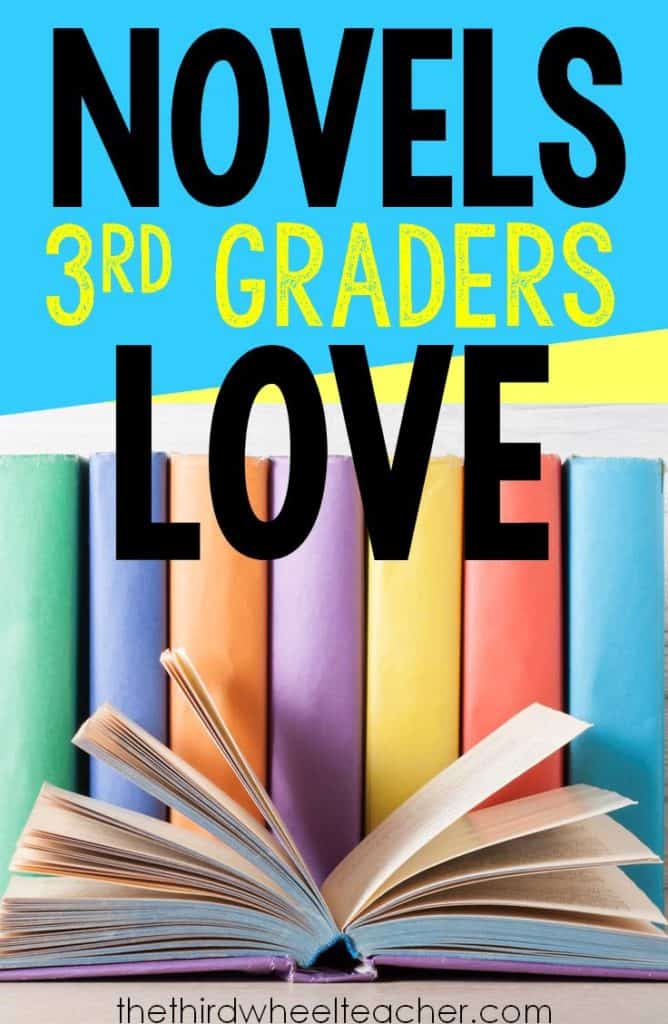Differentiate your novel unit without spending hours planning
t can feel challenging to find ways to differentiate reading instruction when your students are at such vastly different levels. You may find yourself questioning whether some strategies are a good fit for your struggling learners…and the truth is, sometimes they aren’t. Novel studies, however, aren’t one of those because differentiating your novel unit can be done quickly and offer your reluctant and below-level readers a chance to fit in with peers when it comes to reading.
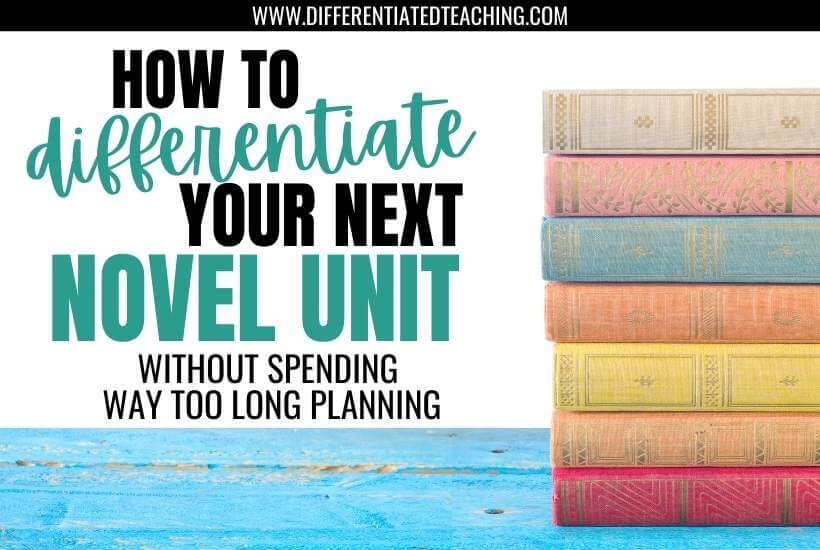
What are some ways to differentiate instruction?
Before we dive into the specifics of differentiation for novel units, I want to make sure we’re all on the same page regarding how we can make adjustments for our learners.
There are four main ways to differentiate instruction. They are:
- Content – The content is the actual material being taught. While we typically don’t differentiate the goal or outcome we’re trying to achieve, we might use curriculum compacting for advanced learners or offer the material in multiple formats or levels.
- Process – This is how students come to understand the content presented. This includes adjustments to pacing, grouping, and various supports.
- Product – This is how students show their learning. Tests, assignments, and projects can all be differentiated to align with students’ interests and learning preferences.
- Environment – The learning environment means the actual classroom, but it can also meet the mental space students are working in. Acknowledging that students may need different amounts of encouragement or emotional needs when learning is one piece of this.
For the purpose of today’s article, we’ll focus our energy primarily on the first three. While it is essential to made decisions about the learning environment and design it to best fit student needs, the most common strategies we use to differentiate fall into one of the three categories – content, process, or product.
How to differentiate your novel unit without a ton of prep
One of the biggest hesitations many teachers feel when it comes to differentiation is the time it takes to prep. However, there are many simple ways to differentiate that don’t require separate lessons or a ton of extra time to prepare.
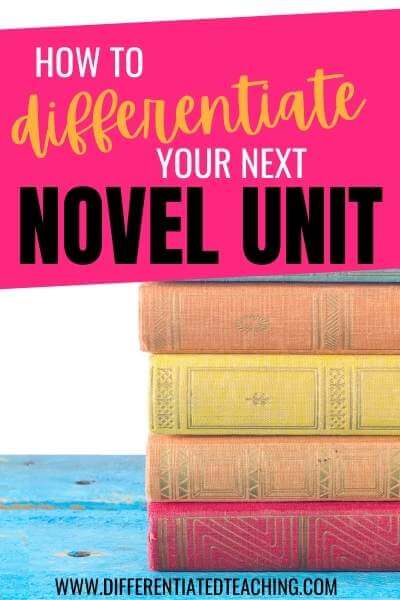
To help you find what’s right for you and your students, I’ve coded these strategies based on how time-intensive each is. You’ll see that each option is rated as green, yellow, or red depending on the intensity of planning required.
Here’s a brief overview:
- Green– This strategy for differentiated instruction is quickly done before beginning your unit. This strategy doesn’t require any additional resources or significant extra time for daily planning.
- Yellow – This strategy requires a bit more planning or preparation time throughout the unit. Alternatively, it may require additional instructional resources.
- Red – This strategy will consistently require more time and attention throughout your unit. You will need to plan for extra prep throughout your unit.
Differentiate the content of your novel unit
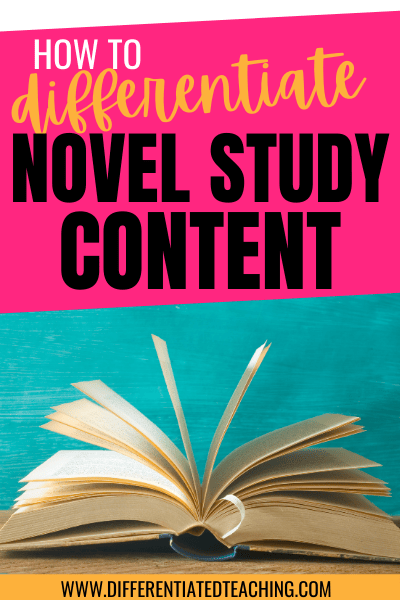
If you’ll remember from above, content differentiation focuses on how we adjust the materials used to teach.
This is often our go-to when it comes to differentiating novel units because it is simple and requires very little additional time spent preparing after you make your final choices.
Whether you’re teaching in person or remotely, there are several easy ways to modify the materials and methods you’re incorporating into your novel unit.
Here are two super simple ways you can differentiate when it comes to content:
Offer Options for Novel Selection
While most people think of this as offering books at different reading levels. This is far from the only differentiation strategy you can use when picking what books to read.
Offering students voice and choice when it comes to picking what they want to read is consistently discussed to engage learners in reading.
The popularity of Donalyn Miller’s The Book Whisperer (affiliate link) has helped push this discussion to the forefront in many schools that were previously reliant on basal readers.
That being said, it can be completely overwhelming (and a ton of work) for a teacher to read 25 different books so you can have a sense of what students are reading.

While you might not be ready to completely release control of the book choice to your readers, you can make some simple changes to hand over control of student book selections. One of the easiest is to identify several books you’d be interested in having your learners read.
Spend some time on pre-reading activities that introduce the novels. Conducting a book tasting or watching a book trailer can help students identify which text might be the best fit for them.
Once you’ve familiarized your class with their options, you can allow them to choose what they’d prefer to read. This helps make sure your books are a good match for students and consider differences in student interest.
Rating: Green-Yellow (depending on how you allow students to choose the text)
Utilize Audiobooks

Struggling or reluctant readers are often skilled at “fake reading.” They’ve mastered the art of staring at the pages and every so often turning them. One way to support this group is to offer the option to listen to an audiobook.
Depending on your goals, you may choose to have students follow along in the text. However, there might also be times that your learners don’t need to have the books in their hands to achieve your instructional goals.
If you’ve got learners with dyslexia or other identified reading disabilities, Learning Ally and Book Share are both options, and they can be an excellent tool for supporting virtual learners during novel studies.
Audiobooks can also be great for students who are learning English.
Rating: Green
As you can see, the process of differentiating content tends to happen mostly at the beginning of the unit. There’s not a ton of extra prep that you’ll have to do throughout your unit unless you decide to allow for many different novels.
Process-focused differentiated instruction strategies for novel studies
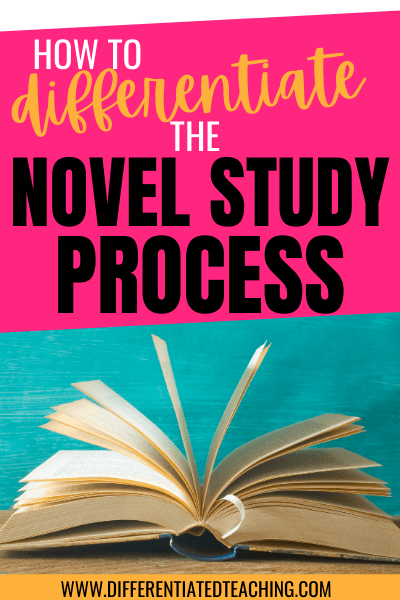
Unlike content adjustments, differentiating the process varies quite a bit when it comes to how much extra work it can become for a teacher.
However, many teachers find that differentiating the process comes naturally to them so this additional work doesn’t feel overwhelming or stressful.
Other teachers find that the time and effort that it takes for process differentiation is well worth it because students get so much more from their reading.
Here are a few options to consider:
Adjust the pacing.
One easy, low-prep way to incorporated differentiated instruction into your novel unit is to adjust the pacing based on student needs. For example, your advanced learners may complete two chapters each day while your lower reading group only completes one.
You might also consider having some students read (or listen to) one chapter at home and the other in class to keep the groups moving along together.

Rating: Green
Offer options for grouping.

Another easy differentiation strategy that is often done with novel units is adjusting how students are grouped. While some students may love reading independently, others may do better when they work with a partner or a small group.
Adjusting the groups can make it easier for students to experience success and actively engage with the discussion topics.
However, you will want to make sure your groups are a good match because many students decide to pair with friends only to have disastrous results.
Rating: Green-Yellow (difficulty will vary depending on how many groups you decide to have)
Offer different levels of teacher support.
A third way to provide differentiated instruction during your novel unit is to vary the teacher support students receive based on their individual needs.
Some students may need to sit with you and get support to read or generate their response to literature. Other groups may be able to function more independently. Other learners may just need more frequent check-ins to make sure they understand and are on track.

For those students who struggle to focus, the numerous check-ins won’t require much prep time if any at all. However, those who need additional support with reading and responding will require a great deal of advanced preparation.
Rating: Yellow-Red (dependent on your students’ needs)
Use graphic Organizers or provide sentence stems.
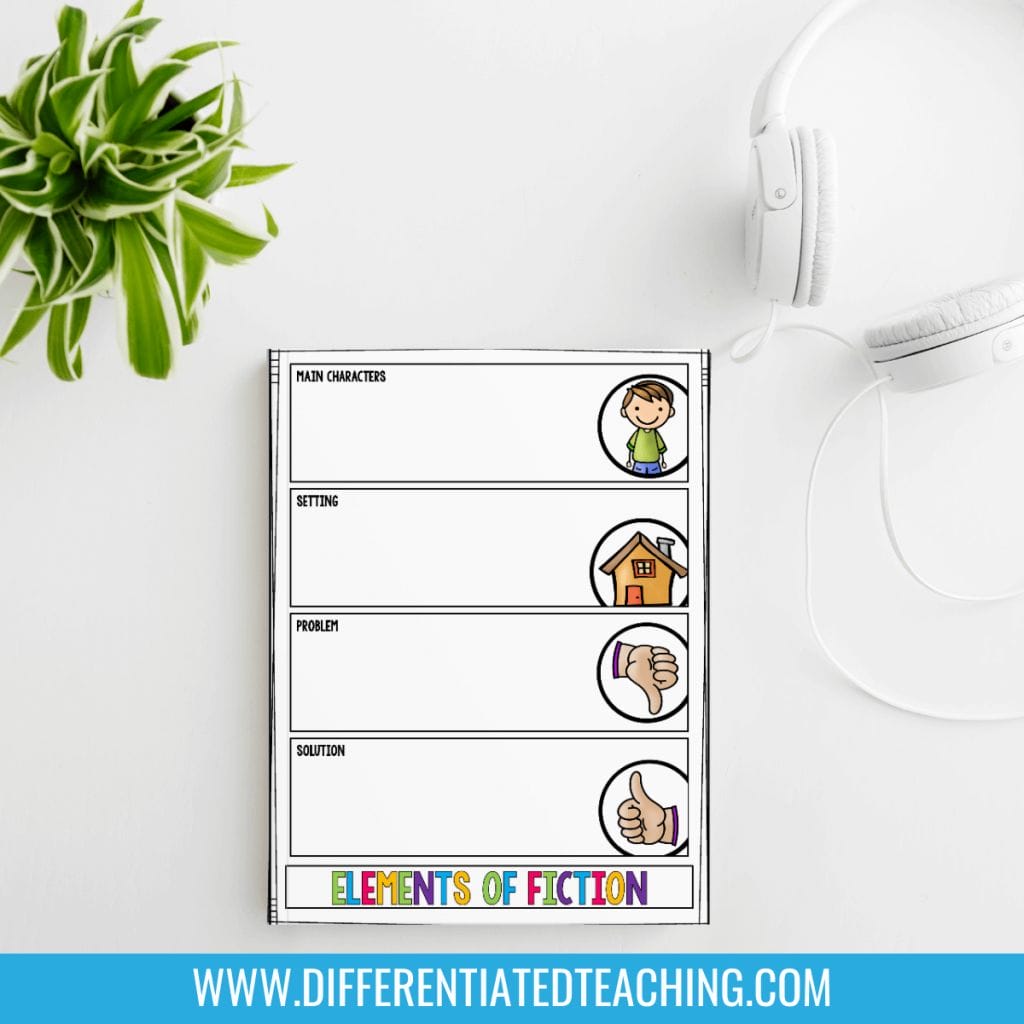
Another option is to provide graphic organizers to students who may need to document or organize their understanding as they read or prepare their responses. You may find students need different organizers depending on their abilities and interest.
Some learners may benefit from graphic organizers that allow them to record comprehension details – such as the cause and effect relationships they identify as they read.
Other learners may need sentence stems or graphic organizers to help them record and organize the details of their responses.
Rating: Yellow
Add visuals and vocabulary support.
Visual supports and pre-teaching vocabulary are often discussed for ELLs, but they can be a great strategy to use with any struggling or reluctant reader. This is especially true when your books have numerous unfamiliar words that can be a barrier to understanding and participating fully in class discussions.
Creating a visual word wall may be one of the more time-consuming ways you can differentiate a novel unit, but if you keep those words, you can use them the next time you read the book.
Here’s an example of what you might include on your visual word wall:
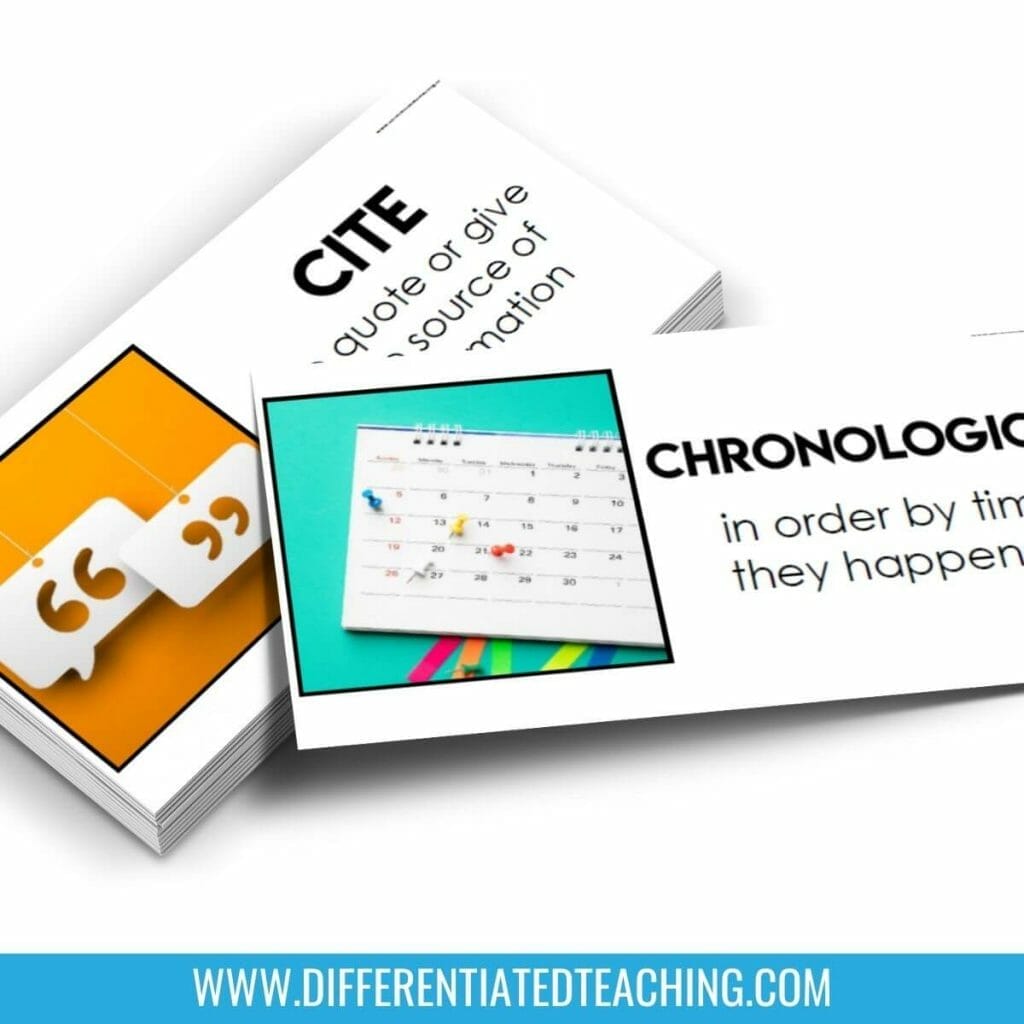
Rating: Red
Provide modeled responses.
Another strategy you might use is modeling responses. This can be good for students who often struggle to know how to begin or struggle to meet expectations.
By modeling, you can show exactly what a high-quality response looks like. This can allow your students to transition that understanding into their own writing.
Many students will only need to be shown the level of detail you expect once. Yet, there will likely be some who will need you to model how to structure their response each day.
You can do a shared writing activity with students and erase it before having them generate their own responses. You could also prepare a response beforehand and have students examine yours and look for the key features you expect.
Rating: Yellow-Red (depending on whether you write these in advance)
Flip your instruction.
Finally, you may consider flipping your instruction. There are two ways to do this. First, you may have students come to class having pre-read the day’s chapters. This allows you to use your time in class to discuss and make meaning of the text.
Alternatively, you can film a short mini-lesson for students to watch. If you focus on the specific comprehension skill in your video, you can give time to read, discuss, and respond in class.

Rating: Red
Product-focused differentiation strategies for novel studies
Most teachers find product differentiation to be the easiest way to provide differentiated instruction. However, if you’ve ever given students the choice of how they show their learning, you know the challenge you face as a teacher trying to fully assess student knowledge when each student does a different final project.
There’s just no comparing the understanding of a group of students who choose to do an interpretive dance with one that decides to write a 10-page report. In fact, several teachers have mentioned being afraid to offer options because it leads to parent emails about grading.

That being said, some differentiation options are an excellent fit for novel units. These tips will help you make sure you don’t end up overwhelmed trying to figure out what students learned.
Offer multiple ways to participate.
While some students may prefer to have live discussions, others may feel more confident if they can share their thoughts on a virtual discussion board.
Remote learners may be especially appreciative of having options. This lets them align the work with their family’s schedules. Many working parents appreciate the flexibility of asynchronous responses.
Just be prepared to monitor these discussions and help guide learners. You may find student participation increases when you offer more than one way to jump into a book group. However, you’ll also need to be prepared to do more clarification.
Rating: Red
Create a shared rubric, but allow learners to choose their final project.
Book reports are tedious and can ruin the excitement we’ve worked so hard to generate throughout a novel unit. However, there are many engaging book report alternatives that students really enjoy.
That being said, I’ve seen this go wrong so often and become way more work than it needs to be. Creating a rubric that you share with your students is one way to keep this less stressful.
Giving requirements in advance helps pupils pick a post-novel project that genuinely shows their understanding of the book. You can also use your rubric to create a menu of final products that you’d feel comfortable accepting.
Giving students the freedom to chose how they show their learning can help keep engagement high. Tying in real-world skills can also be incredibly helpful. For example, you might have students write a review of the book on Goodreads. You could also allow them to create a website for the book using a simple tool like Google Sites.
Rating: Green-Yellow
Modify the expectations based on students needs.
Another option is to differentiate your expectations for the final product. This can be a good way to keep reluctant or struggling students who are self-conscious from sticking out from their peers because all students are working on the same project with adjustments to grading. Here are a few ways you might achieve this:
- Adjust the length of written responses
- Allow for oral responses vs. written
- Reduce the number of examples or amount of text evidence required for full points
- Allow students to type their responses.
For example, you might ask your class to write the main idea for each of the chapters they read that day. However, you may only require struggling students to complete one main idea independently and you might do the other two together.
Rating: Green-Yellow
Creating a positive learning experience with books
Regardless of how you decide to differentiate, finding ways to help students engage and enjoy novels is a great way to help foster a love of reading while you build essential comprehension skills.
If you need some great books to help you get started, check out my favorite novels for 3rd, 4th, and 5th grades.

